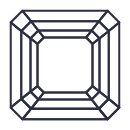
Understanding the intricacies of precious stones
Rock In A Box is here to support you in all aspects of your purchase. We want you to be comfortable and confident that you’re getting exactly what you want.
If this is your first purchase, we encourage you to take the time to understand the intricacies of diamonds in particular. You’ve already made one big decision; we want you to be just as sure with this next one, your purchase.
Through our consultation process we’ll aim to educate you on why we are recommending certain stones. And we promise not to overwhelm you in the process with industry jargon.

Quick links
The 4Cs of Diamond Quality
The Gemmological Institute of America (GIA), the world’s leading authority on diamonds, created in the 1940s the 4Cs: Colour, Cut, Clarity and Carat Weight. This is now the global standard for assessing the quality of diamonds and allows you to compare one diamond to another.
Colour
Understanding what diamond colour means will assist in choosing the right diamond, the term colour however can be a little misleading. When we refer to the colour of a diamond, it in fact means the absence of colour. A chemically pure and structurally perfect diamond has no hue and consequently a higher value. GIA’s D to Z diamond colour grading system measures the degree of colourlessness by comparing a stone under controlled lighting and precise viewing conditions to masterstones. Many of these distinctions are so subtle they are invisible to the untrained eye, however they make a big difference to diamond quality and price. When referring to the D to Z grading system, D is the highest quality diamond indicating the stone is colourless, and continues to Z with the increased presence of colour.
Cut
Cut should not be confused with shape. The cut of a diamond relates to how well a diamond’s facets interact with light, in short the cut affects the intensity of the sparkle.
This becomes a critical part of the selection process when sourcing a diamond as achieving a high quality cut requires precise artistry and workmanship so the proportions, symmetry and polish of the stone deliver the magnificent return of light.
Clarity
Natural diamonds are the result of carbon exposed to tremendous heat and pressure deep in the earth. This process can result in a variety of internal characteristics known as ‘inclusions’ and external characteristics known as ‘blemishes’.
The GIA Clarity Scale has 6 categories, some of which are divided for a total of 11 grades of clarity. Evaluating diamond clarity involves determining the number, size, relief, nature and position of the characteristics which contribute to the overall appearance of the stone. Many inclusions and blemishes will not be noticeable to the untrained eye and therefore it is critical that these diamonds are assessed by experts in the field.
Carat
Diamond carat refers to the weight of the diamond, often considered the size of the stone. A metric ‘carat’ is defined as 200 milligrams. Each carat can be subdivided into 100 ‘points’, allowing very precise measurements.
All else being equal, diamond price increases with carat weight.
Shape
The most popular shapes for diamonds and gemstones

Round

Princess

Emerald

Asscher

Marquise

Oval

Radiant

Pear

Heart

Cushion
Natural Diamonds v Lab Grown Diamonds
As the name suggests, natural diamonds are earth mined and lab grown diamonds are developed in a lab, also known as synthetic diamonds.
So what’s the difference?
Lab grown diamonds will have exactly the same physical, chemical, and optical properties as natural diamonds. The technology is so good that diamond manufacturers are able to duplicate the conditions that create diamonds over millions of years in just a few months. As there is essentially no difference in appearance or quality it comes down to personal choice as to whether a person will buy a natural diamond or lab-grown diamond.
People’s preference for lab grown diamonds can include a sustainability element as they aren’t mined from the earth. There can also be a significant saving when compared to the same natural diamond.
At the end of the day, the decision and preference are entirely yours. Both are diamonds and both are graded using the exact same system.
GIA Certification
At Rock In A Box, we are proud to offer only GIA Certified diamonds and gemstones.
The GIA is the worlds most trusted name in diamond grading and gem identification. By purchasing a GIA certified stone, you are obtaining consistency in grading and an internationally recognised certificate.
It is also the preferred certificate for insurance companies when endeavouring to source and replace a stone following an insurance claim.
When you purchase your diamond from Rock In A Box your GIA Certificate will be provided with your natural diamond purchase. The certificate will contain a detailed report that includes a full quality analysis of shape and cutting style, measurements, carat weight, colour grade, clarity grade, cut grade (for brilliant round-cut diamonds), polish and symmetry assessments, and fluorescence.
The report also includes a plotted diagram indicating the relative size and location of clarity characteristics, a proportion diagram, and GIA grading scales.
GIA certificates will be offered for all Natural diamonds. Lab grown diamonds will come with an international Diamond Certificate.
Jewellery Insurance
Have you thought about insurance to protect your jewellery? Your new ring will arrive with 12 months FREE Q Report Jewellery Insurance.